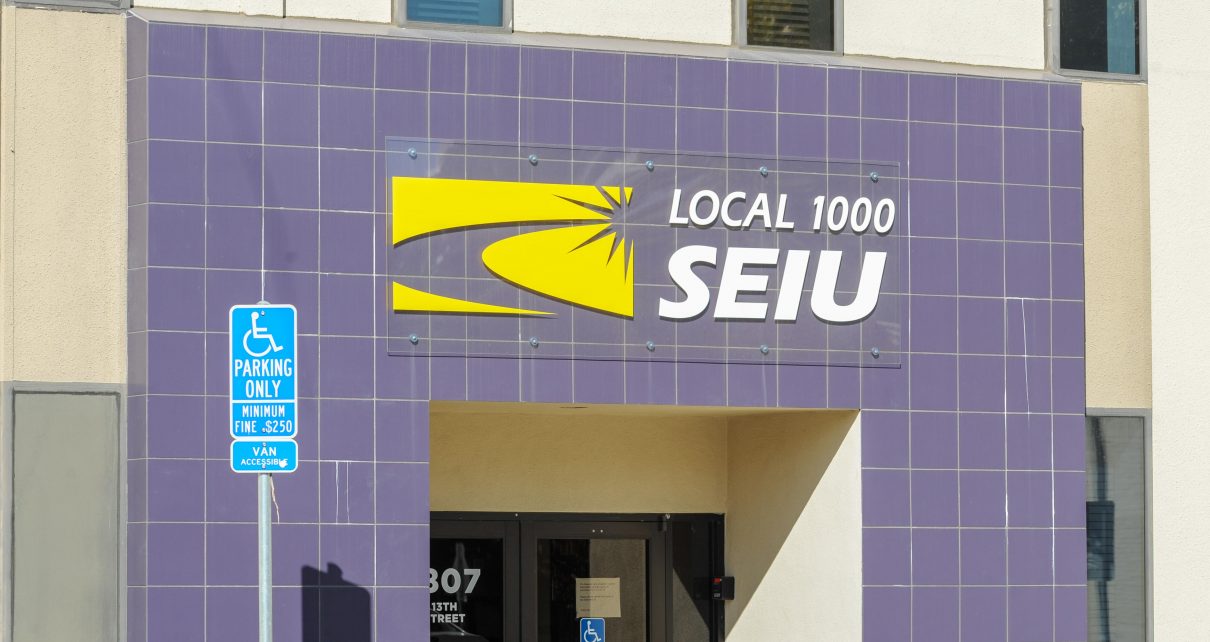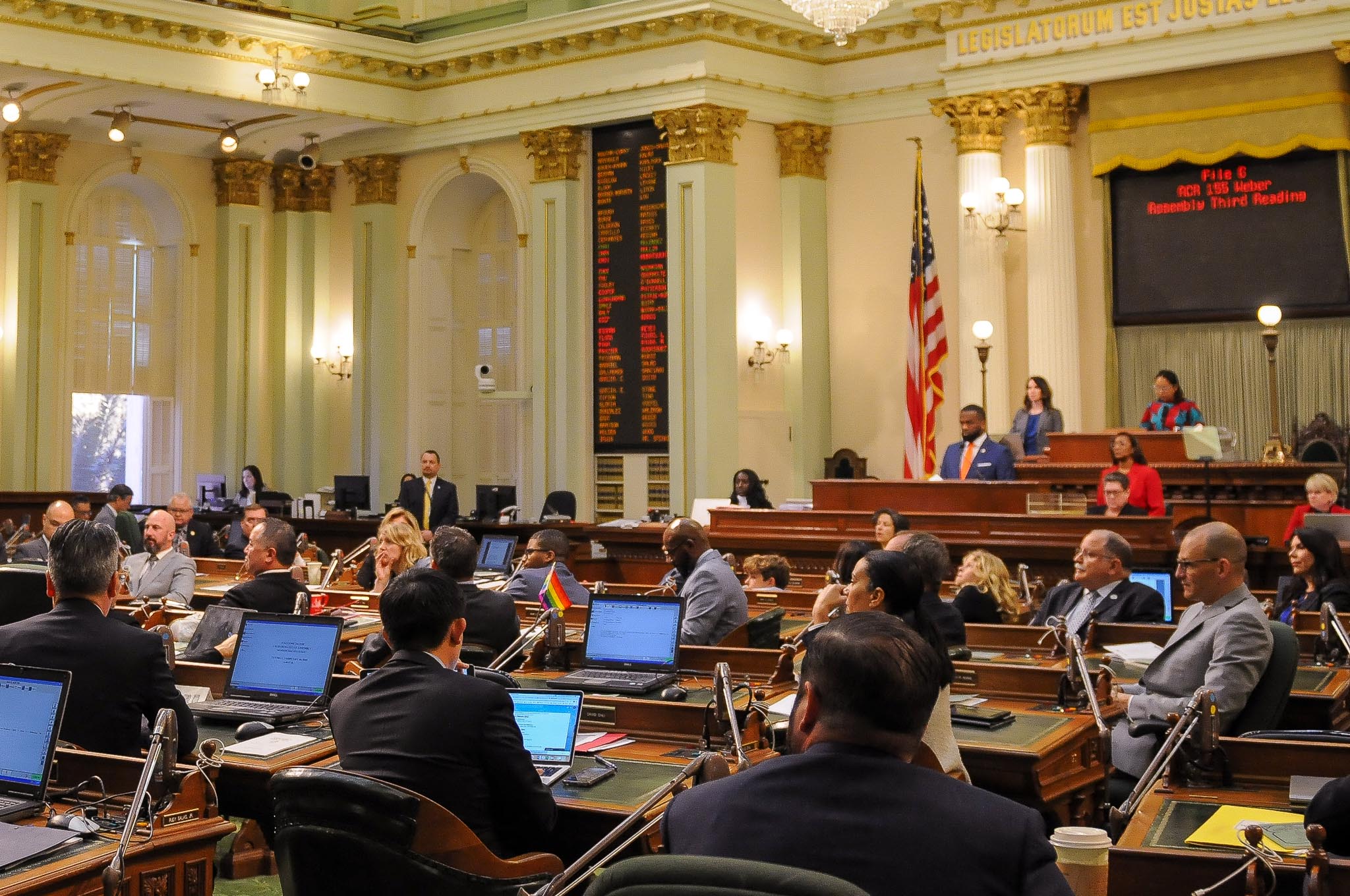
Local 1000 SEIU Sign. (Photo: Kevin Sanders for California Globe)
Union Representation Dips In California in 2022
As organized labor faces complicated 2023, expect unionization drives to increase
By Evan Symon, February 3, 2023 1:44 pm
Union representation went down in California in 2022 from 17.8% of jobs to 17.6% of jobs according to a recent report by the Bureau of Labor Statistics (BLS), with both unionization and deunionization efforts increasing statewide.
Since reaching a peak of nearly 30% of all jobs nationwide being unionized in the post-WWII 1940’s and 1950’s, the number of unionized jobs in the U.S. has cratered. By 1983, union membership was only at 20.1% covering 17.7 million workers. By 1995 it had dipped below 15% to 14.9% and under 11% to 10.7% in 2016. While the number of Americans viewing unions as favorable has shot up by 16% from 2012 to 2022, with many union efforts now targeting service industries, total union membership has continued to collapse. According to the recently released BLS report, union membership in the U.S. sat at 10.1% in 2022, covering 14.3 million workers.
In California the results have been more mixed. Total union membership has stayed somewhat steady since the Great Recession, fluctuating between 17% and 15%. Direct union membership actually rose from 2021 to 2022, with the rate going from 15.9% to 16.1%. However, the more critical rate of workers represented by unions, which covers positions even though workers themselves may not have joined the union, fell from 17.8% to 17.6% during that same time.
While California still has the most union members of any state, at 2.6 million last year, the .2% loss of workers represented by unions moved California down to only the fifth highest in the U.S., falling behind New York, Hawaii, Washington state, and Rhode Island. Comparatively, the quickly growing economies of Texas and Florida had union rates of 5.1% and 5.6% respectively, with the national represented by union rates being at 11.3% for 2022.
Overall, renewed unionization efforts in both the private and public sectors fueled the slight growth in direct number of union members in the past year, while tech sector job losses and the continued pullout of Californian companies helped spur the union represented losses. Public sector unions have also kept California’s unionized rates to erode less than what has been happening nationally, with nearly 60% of all public sector jobs being unionized in California, as compared to under 10% of private sector jobs.
The mixed reports led to mixed reactions from both union and business leaders. Some union leaders, such as UNITE HERE Local 2 spokesman Ted Waechter, were positive about union growth in California, noting on Thursday that “Workers in California, especially those in the hospitality industry, are fired up and ready to organize unions at an unprecedented level.” However, others were far more reserved on the future of unions in California.
Unionization at crossroads in California
“Right now unions in California are trying to pull up after huge losses in previous decades and are trying to buck the national trend,” said Jesus Lopez, a leader for a local union in Los Angeles, to the Globe on Friday. “The California Labor Federation and many teachers unions have led huge unionization efforts in the past several years, and you can see that having an effect. Rates have been stabilizing.”
“But, and this is something unions in California won’t say, it ignores some big industries. Like car manufacturing. Look at where all the car factories are. Texas, Tennessee, Indiana. Low union membership states, with many being right-to-work. Even Michigan, home of the car, is right-to-work now. Now look at California. One car factory, Tesla. And they have successfully fought off unions like the UAW. But even then, Tesla is still building a new car factory in Austin.”
“But that’s lucky. A lot of companies have been leaving California due to higher costs, and yes, part of the higher costs do come in the form of higher union wages. And you also have to remember that California increasing the minimum wage by a lot during the past several years has really kept union growth in check. Especially for fast food workers. The few that have unionized, like some Starbucks locations, have seen many of those locations close as a result.
“In 2023, you can expect unionization drives to increase, with a lot of places also appealing to the NLRB to have votes take place. Union busting firms are going to boom in California in the coming years for sure. A lot of people wanting unions think his is a good atmosphere. But to some, like me, we see that it’s not all rosy. If we’re successful in getting more places unionized, we also know that a lot of these places will suddenly find that those locations that unionized are suddenly not profitable, or that they’re going to move out to Arizona or Texas now due to the rising expenses. They’re only going to take so much, you know?”
Other union membership figures are expected to be released later this year.
- New Reports Finds EPA Will Likely Give A Waiver For California’s 2035 Gas-Powered Car Sales Ban Mandate - December 14, 2024
- Port Of Oakland Appeals Temporary Court Ruling Blocking use of ‘San Francisco Bay’ In Name - December 13, 2024
- Farmers Insurance to Increase Number Of Homeowner & Renter Policies in California - December 12, 2024





For most of America’s history, public employee unions were illegal. The reason being is that the taxpayers don’t actually negotiate with the public employee unions and there is a great danger of those unions actually capturing legislators and other government officials through campaign contributions and other means. This is exactly what has happened in California where public employee unions have been captured by the corrupt Democrat cabal.